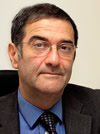OSA Congratulates Physics Nobel Prize Winners
About Optica
09 October 2012
OSA Congratulates Physics Nobel Prize Winners
FOR IMMEDIATE RELEASE
Contact:
Lyndsay Meyer
The Optical Society
+1.202.416.1435
lmeyer@osa.org
OSA Congratulates Physics Nobel Prize Winners
OSA Fellow David Wineland and Serge Haroche win for work on quantum measurement

Serge Haroche Credit: College of France

David Wineland Credit: NIST
WASHINGTON, Oct. 9, 2012 – The Optical Society (OSA) today congratulated OSA Fellow David J. Wineland of the U.S. National Institute of Standards and Technology (NIST) and Serge Haroche of Collége de France for being awarded the 2012 Nobel Prize in Physics by the Royal Swedish Academy of Sciences. The award is bestowed annually upon the person who has made “the most important discovery or invention within the field of physics.” Wineland joins the more than 25 OSA members that have achieved this admirable distinction in physics.
The pair received the award "for ground-breaking experimental methods that enable measuring and manipulation of individual quantum systems." This prestigious award will be presented by His Majesty King Carl XVI Gustaf of Sweden during a ceremony Dec. 10 at the Stockholm Concert Hall.
Wineland developed a method for using lasers to cool ions to absolute zero, which allows scientists to measure and study individual atoms without disturbing their sensitive quantum states. His research contributed to the Nobel Prize-winning work in laser cooling and trapping by OSA members Steven Chu, William Phillips and Claude Cohen-Tannoudji in 1997, as well as the work of OSA members Eric Cornell, Wolfgang Ketterle and Carl Wieman, who received the 2001 Nobel Prize for creating the world’s first Bose-Einstein condensate. Haroche is known for his work in quantum coherence. His experiments involve trapping photons—particles of light—between two mirrors in order to study their quantum state. His method allows researchers to observe the photons just long enough before they decay, providing an important window into the understanding and controlling of particles.
According to the Royal Swedish Academy of Sciences, “Haroche and Wineland have opened the door to a new era of experimentation with quantum physics by demonstrating the direct observation of individual quantum systems without destroying them.” Both Wineland and Haroche’s work has led to the development of extremely accurate atomic clocks and helped launch the field of quantum computing.
“Understanding the fundamentals of quantum physics is crucial for scientific developments in today’s world,” said OSA CEO Elizabeth Rogan. “The contributions by David and Serge are widely recognized in the optics community and their work has had significant effects on our understanding of particles and their quantum states. Our members are consistently providing breakthrough advances to science as we know it. Without David and Serge’s research, innovation and achievements, quantum physics would not be where it is today. We congratulate them on this much-deserved recognition.”
Wineland is a physicist at NIST in Boulder, Colo. He received his Ph.D. in physics from Harvard in 1970 and is the recipient of numerous awards, including the National Medal of Science, the American Physical Society’s Arthur L. Schawlow Prize in Laser Science, and OSA’s Herbert Walther Award and Frederic Ives Medal. Haroche is a professor at the Collége de France in Paris. He received his Ph.D. in 1971 from Université Pierre et Marie Curie in Paris. He has been recognized for his work through many awards, including the Quantum Electronics Prize from the European Physical Society, and OSA’s Charles Hard Townes Award and Herbert Walther Award.
About OSA
Uniting more than 180,000 professionals from 175 countries, the Optical Society (OSA) brings together the global optics community through its programs and initiatives. Since 1916 OSA has worked to advance the common interests of the field, providing educational resources to the scientists, engineers and business leaders who work in the field by promoting the science of light and the advanced technologies made possible by optics and photonics. OSA publications, events, technical groups and programs foster optics knowledge and scientific collaboration among all those with an interest in optics and photonics. For more information, visit www.osa.org.
